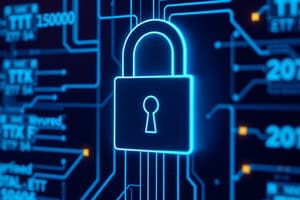Podcast
Questions and Answers
What does 3DES stand for?
What does 3DES stand for?
- Data Encryption Standard
- Triple DES (correct)
- Single DES
- Double DES
What is the purpose of the Advanced Encryption Standard (AES)?
What is the purpose of the Advanced Encryption Standard (AES)?
AES is a block cipher type of encryption that comes in 128, 192, and 256 bits.
What does an authentication header (AH) provide?
What does an authentication header (AH) provide?
Authentication, integrity, and anti-replay for data packets.
What is ARP Spoofing?
What is ARP Spoofing?
Access Control is solely about restricting physical access.
Access Control is solely about restricting physical access.
What happens during an account lockout?
What happens during an account lockout?
What is Active Directory used for?
What is Active Directory used for?
What type of share is only accessible by administrators?
What type of share is only accessible by administrators?
What is Adware?
What is Adware?
What does Antivirus software do?
What does Antivirus software do?
What is an Application-Level Firewall?
What is an Application-Level Firewall?
What is Asymmetric Encryption?
What is Asymmetric Encryption?
What is meant by Attack Surface?
What is meant by Attack Surface?
What does Auditing track?
What does Auditing track?
What does Authentication involve?
What does Authentication involve?
What is the CIA Triangle?
What is the CIA Triangle?
A Backdoor is a form of malware used to perform _______ tasks on a system.
A Backdoor is a form of malware used to perform _______ tasks on a system.
What is a Certificate Authority (CA)?
What is a Certificate Authority (CA)?
What does CHAP stand for?
What does CHAP stand for?
What is the purpose of a Certificate Revocation List (CRL)?
What is the purpose of a Certificate Revocation List (CRL)?
Flashcards are hidden until you start studying
Study Notes
Encryption
- 3DES is a block cipher encryption method offering stronger security than DES.
- AES is another block cipher encryption method available in 128, 192, and 256 bit variations.
- Asymmetric Encryption uses separate keys for encryption and decryption.
Security Mechanisms
- Access Control restricts access to systems and data, ensuring authorized individuals can access information while preventing unauthorized access.
Network Security
- Authentication Header (AH) safeguards data packets by providing authentication, integrity, and anti-replay protection.
- ARP Spoofing manipulates MAC address/IP address combinations, enabling attackers to redirect network traffic to their machines by stealing legitimate IP addresses.
- Circuit Filtering analyzes data at the Session layer (Layer 5) of the OSI model, filtering based on session information.
Malware and Attacks
- Adware displays advertisements while applications are in use.
- Backdoors provide unauthorized access to systems, allowing malicious activities to be performed.
- Botnets are networks of compromised computers controlled by attackers, often used in DDoS attacks.
- Brute Force Attacks attempt to guess passwords by systematically trying all possible character combinations.
- Buffer Overflow occurs when data exceeds allocated storage space, potentially causing system performance issues, crashes, or security vulnerabilities.
- Cross-Site Scripting Attacks inject malicious scripts, bypassing web browser security measures.
- DDoS Attacks overwhelm systems with traffic from multiple sources, resulting in service disruption.
Authentication
- Biometrics leverages physical traits like fingerprints, retinal scans, or facial recognition for authentication.
- Challenge Handshake Authentication Protocol (CHAP) uses MD5 hashing for challenge-response authentication.
Certificates and Revocation
- Base-64-Encoded X.509 certificates store a single certificate but not a private key.
- Certificate Revocation List (CRL) maintains a list of revoked certificates, due to expiration or compromise.
Other Security Concepts
- Account Lockout prevents unauthorized access by locking accounts after multiple failed login attempts.
- Active Directory is a Windows directory service used for managing user accounts, groups, printers, devices, and other network objects.
- Administrative Share restricts access to administrators, backup operators, and server operators.
- Antispam software filters out unwanted email messages.
- Antivirus software detects and removes malware.
- Application-Level Firewall operates at the application layer (Layer 7) of the OSI model, filtering based on specific applications.
- Attack Surface encompasses all potential vulnerabilities that attackers could exploit.
- Auditing logs user activity, tracking login attempts and data access for security monitoring.
- Availability ensures access to data and systems when needed.
- Confidentiality safeguards data and systems from unauthorized access.
- Cookies store information from webpages, such as user data, preferences, and shopping cart items.
- Distinguished Encoding Rules (DER) are a binary format used to encode X.509 certificates.
- BitLocker encrypts entire drives.
- BitLocker To Go encrypts removable drives.
- Block Cipher encrypts data blocks using a key.
- CIA Triangle represents the core principles of security: confidentiality, integrity, and availability.
Studying That Suits You
Use AI to generate personalized quizzes and flashcards to suit your learning preferences.




